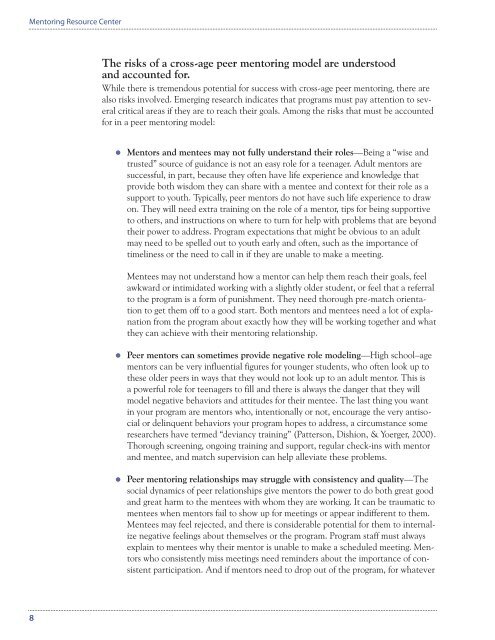1zRGGrv
1zRGGrv
1zRGGrv
Create successful ePaper yourself
Turn your PDF publications into a flip-book with our unique Google optimized e-Paper software.
Mentoring Resource Center<br />
The risks of a cross-age peer mentoring model are understood<br />
and accounted for.<br />
While there is tremendous potential for success with cross-age peer mentoring, there are<br />
also risks involved. Emerging research indicates that programs must pay attention to several<br />
critical areas if they are to reach their goals. Among the risks that must be accounted<br />
for in a peer mentoring model:<br />
Mentors and mentees may not fully understand their roles—Being a “wise and<br />
trusted” source of guidance is not an easy role for a teenager. Adult mentors are<br />
successful, in part, because they often have life experience and knowledge that<br />
provide both wisdom they can share with a mentee and context for their role as a<br />
support to youth. Typically, peer mentors do not have such life experience to draw<br />
on. They will need extra training on the role of a mentor, tips for being supportive<br />
to others, and instructions on where to turn for help with problems that are beyond<br />
their power to address. Program expectations that might be obvious to an adult<br />
may need to be spelled out to youth early and often, such as the importance of<br />
timeliness or the need to call in if they are unable to make a meeting.<br />
Mentees may not understand how a mentor can help them reach their goals, feel<br />
awkward or intimidated working with a slightly older student, or feel that a referral<br />
to the program is a form of punishment. They need thorough pre-match orientation<br />
to get them off to a good start. Both mentors and mentees need a lot of explanation<br />
from the program about exactly how they will be working together and what<br />
they can achieve with their mentoring relationship.<br />
Peer mentors can sometimes provide negative role modeling—High school–age<br />
mentors can be very influential figures for younger students, who often look up to<br />
these older peers in ways that they would not look up to an adult mentor. This is<br />
a powerful role for teenagers to fill and there is always the danger that they will<br />
model negative behaviors and attitudes for their mentee. The last thing you want<br />
in your program are mentors who, intentionally or not, encourage the very antisocial<br />
or delinquent behaviors your program hopes to address, a circumstance some<br />
researchers have termed “deviancy training” (Patterson, Dishion, & Yoerger, 2000).<br />
Thorough screening, ongoing training and support, regular check-ins with mentor<br />
and mentee, and match supervision can help alleviate these problems.<br />
Peer mentoring relationships may struggle with consistency and quality—The<br />
social dynamics of peer relationships give mentors the power to do both great good<br />
and great harm to the mentees with whom they are working. It can be traumatic to<br />
mentees when mentors fail to show up for meetings or appear indifferent to them.<br />
Mentees may feel rejected, and there is considerable potential for them to internalize<br />
negative feelings about themselves or the program. Program staff must always<br />
explain to mentees why their mentor is unable to make a scheduled meeting. Mentors<br />
who consistently miss meetings need reminders about the importance of consistent<br />
participation. And if mentors need to drop out of the program, for whatever<br />
8


